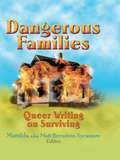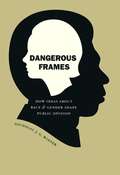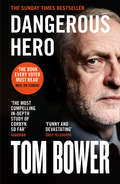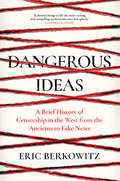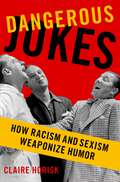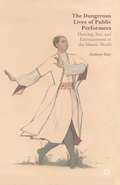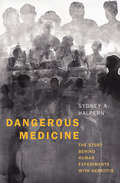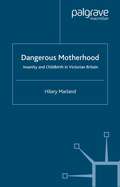- Table View
- List View
Dangerous Familiars: Representations of Domestic Crime in England, 1550-1700
by frances E. DolanLooking back at images of violence in the popular culture of early modern England, we find that the specter of the murderer loomed most vividly not in the stranger, but in the familiar; and not in the master, husband, or father, but in the servant, wife, or mother. A gripping exploration of seventeenth-century accounts of domestic murder in fact and fiction, this book is the first to ask why.Frances E. Dolan examines stories ranging from the profoundly disturbing to the comically macabre: of husband murder, wife murder, infanticide, and witchcraft. She surveys trial transcripts, confessions, and scaffold speeches, as well as pamphlets, ballads, popular plays based on notorious crimes, and such well-known works as The Tempest, Othello, Macbeth, and The Winter's Tale. Citing contemporary analogies between the politics of household and commonwealth, she shows how both legal and literary narratives attempt to restore the order threatened by insubordinate dependents.
Dangerous Families: Queer Writing on Surviving
by Matt Bernstein SycamoreQueer survivors piece together the clues to discover their own lives! Dangerous Families: Queer Writing on Surviving goes beyond the recovery narrative to create a new queer literature of investigation, exploration, and transformation. Twenty-six stories illuminate the reality of growing up in fear, struggling to rebuild lives damaged by sexual, physical, and/or emotional abuse. The book explores how abuse turns queer survivors-male, female, and transgendered-into healers, heartbreakers, and homicidal maniacs, presenting brilliant stories that sear and soar. Dangerous Families: Queer Writing on Surviving addresses all forms of abuse head-on, representing a cross-section of queer survivors in terms of race, class, ethnicity, education, origin, sexuality, and gender. Contributors use their own life experiences to create a book that takes back control from well-meaning "outsiders," as they recount the daily struggle to overcome the damage done to their minds, bodies, and spirits in a world that denies their gender, sexual, and social identities. From the editor: "Dangerous Families consists entirely of writing by survivors of childhood abuse. That's right-no therapists analyzing our plight, no talk-show hosts exploiting us-just survivors, exploring our complicated, frightening, and fulfilling lives. These stories dispense with the usual technique of carefully massaging the reader's fragile worldview before plunging this unsuspecting innocent into a world of horror. They go right to the horror, the beauty, and the joy, often throwing the reader off-guard, revealing layers of meaning before the reader can step back." Dangerous Families: Queer Writing on Surviving is an anthology of 26 true stories of growing up queer in families that magnify the horrors of the outside world instead of offering protection. The book is an essential read for therapists, caseworkers, cultural studies specialists, and anyone struggling to survive childhood abuse.
Dangerous Families: Queer Writing on Surviving
by Matt Bernstein SycamoreQueer survivors piece together the clues to discover their own lives! Dangerous Families: Queer Writing on Surviving goes beyond the recovery narrative to create a new queer literature of investigation, exploration, and transformation. Twenty-six stories illuminate the reality of growing up in fear, struggling to rebuild lives damaged by sexual, physical, and/or emotional abuse. The book explores how abuse turns queer survivors-male, female, and transgendered-into healers, heartbreakers, and homicidal maniacs, presenting brilliant stories that sear and soar. Dangerous Families: Queer Writing on Surviving addresses all forms of abuse head-on, representing a cross-section of queer survivors in terms of race, class, ethnicity, education, origin, sexuality, and gender. Contributors use their own life experiences to create a book that takes back control from well-meaning "outsiders," as they recount the daily struggle to overcome the damage done to their minds, bodies, and spirits in a world that denies their gender, sexual, and social identities. From the editor: "Dangerous Families consists entirely of writing by survivors of childhood abuse. That's right-no therapists analyzing our plight, no talk-show hosts exploiting us-just survivors, exploring our complicated, frightening, and fulfilling lives. These stories dispense with the usual technique of carefully massaging the reader's fragile worldview before plunging this unsuspecting innocent into a world of horror. They go right to the horror, the beauty, and the joy, often throwing the reader off-guard, revealing layers of meaning before the reader can step back." Dangerous Families: Queer Writing on Surviving is an anthology of 26 true stories of growing up queer in families that magnify the horrors of the outside world instead of offering protection. The book is an essential read for therapists, caseworkers, cultural studies specialists, and anyone struggling to survive childhood abuse.
Dangerous Frames: How Ideas about Race and Gender Shape Public Opinion (Studies in Communication, Media, and Public Opinion)
by Nicholas J. WinterIn addition to their obvious roles in American politics, race and gender also work in hidden ways to profoundly influence the way we think—and vote—about a vast array of issues that don’t seem related to either category. As Nicholas Winter reveals in Dangerous Frames, politicians and leaders often frame these seemingly unrelated issues in ways that prime audiences to respond not to the policy at hand but instead to the way its presentation resonates with their deeply held beliefs about race and gender. Winter shows, for example, how official rhetoric about welfare and Social Security has tapped into white Americans’ racial biases to shape their opinions on both issues for the past two decades. Similarly, the way politicians presented health care reform in the 1990s divided Americans along the lines of their attitudes toward gender. Combining cognitive and political psychology with innovative empirical research, Dangerous Frames ultimatelyilluminates the emotional underpinnings of American politics.
Dangerous Frames: How Ideas about Race and Gender Shape Public Opinion (Studies in Communication, Media, and Public Opinion)
by Nicholas J. WinterIn addition to their obvious roles in American politics, race and gender also work in hidden ways to profoundly influence the way we think—and vote—about a vast array of issues that don’t seem related to either category. As Nicholas Winter reveals in Dangerous Frames, politicians and leaders often frame these seemingly unrelated issues in ways that prime audiences to respond not to the policy at hand but instead to the way its presentation resonates with their deeply held beliefs about race and gender. Winter shows, for example, how official rhetoric about welfare and Social Security has tapped into white Americans’ racial biases to shape their opinions on both issues for the past two decades. Similarly, the way politicians presented health care reform in the 1990s divided Americans along the lines of their attitudes toward gender. Combining cognitive and political psychology with innovative empirical research, Dangerous Frames ultimatelyilluminates the emotional underpinnings of American politics.
Dangerous Frames: How Ideas about Race and Gender Shape Public Opinion (Studies in Communication, Media, and Public Opinion)
by Nicholas J. WinterIn addition to their obvious roles in American politics, race and gender also work in hidden ways to profoundly influence the way we think—and vote—about a vast array of issues that don’t seem related to either category. As Nicholas Winter reveals in Dangerous Frames, politicians and leaders often frame these seemingly unrelated issues in ways that prime audiences to respond not to the policy at hand but instead to the way its presentation resonates with their deeply held beliefs about race and gender. Winter shows, for example, how official rhetoric about welfare and Social Security has tapped into white Americans’ racial biases to shape their opinions on both issues for the past two decades. Similarly, the way politicians presented health care reform in the 1990s divided Americans along the lines of their attitudes toward gender. Combining cognitive and political psychology with innovative empirical research, Dangerous Frames ultimatelyilluminates the emotional underpinnings of American politics.
Dangerous Giving in Nineteenth-Century American Literature (American Literature Readings in the 21st Century)
by Alexandra UrakovaThis book explores the dark, unruly, and self-destructive side of gift-giving as represented in nineteenth-century literary works by American authors. It asserts the centrality and relevance of gift exchange for modern American literary and intellectual history and reveals the ambiguity of the gift in various social and cultural contexts, including those of race, sex, gender, religion, consumption, and literature. Focusing on authors as diverse as Emerson, Kirkland, Child, Sedgwick, Hawthorne, Poe, Douglass, Stowe, Holmes, Henry James, Twain, Howells, Wilkins Freeman, and O. Henry as well as lesser-known, obscure, and anonymous authors, Dangerous Giving explores ambivalent relations between dangerous gifts, modern ideology of disinterested giving, and sentimental tradition.
Dangerous Ground: The World of Hazardous Waste Crime
by Donald J. RebovichFor many years, if businesses were caught dumping waste, it was treated more as a nuisance than as a crime; the common images of the criminal and the dumper were worlds apart. In Dangerous Ground, originally published in 1992, Donald J. Rebovich closes this perceptual gap, providing essential information about and analysis of hazardous waste crime and the hazardous waste criminal. This paperback edition includes new material, noting important changes since the book's original publication.Rebovich finds that the criminal dumper is usually an ordinary businessman. The author's research discovers that hazardous waste disposal crimes are more likely driven by the cost of legitimate disposal options, rather than by organized crime figures. It is also a world where one's criminal position is often determined by industry connections and personal relationships.Dangerous Ground places the criminal dumping culture in perspective by detailing the basics of hazardous waste generation, its legitimate disposal, government responses, and efforts to control illegal disposal. An epilogue concludes with an analysis of new threats to our environment posed by gas and oil drilling, declining federal prosecutions, progressive sentencing for offenders, and recommendations on how the global community can effectively address international environmental crime.
Dangerous Ground: The World of Hazardous Waste Crime
by Donald J. RebovichFor many years, if businesses were caught dumping waste, it was treated more as a nuisance than as a crime; the common images of the criminal and the dumper were worlds apart. In Dangerous Ground, originally published in 1992, Donald J. Rebovich closes this perceptual gap, providing essential information about and analysis of hazardous waste crime and the hazardous waste criminal. This paperback edition includes new material, noting important changes since the book's original publication.Rebovich finds that the criminal dumper is usually an ordinary businessman. The author's research discovers that hazardous waste disposal crimes are more likely driven by the cost of legitimate disposal options, rather than by organized crime figures. It is also a world where one's criminal position is often determined by industry connections and personal relationships.Dangerous Ground places the criminal dumping culture in perspective by detailing the basics of hazardous waste generation, its legitimate disposal, government responses, and efforts to control illegal disposal. An epilogue concludes with an analysis of new threats to our environment posed by gas and oil drilling, declining federal prosecutions, progressive sentencing for offenders, and recommendations on how the global community can effectively address international environmental crime.
Dangerous Harvest: Drug Plants and the Transformation of Indigenous Landscapes
by Michael K. Steinberg Joseph J. Hobbs Kent MathewsonThe global drug trade and its associated violence, corruption, and human suffering create global problems that include political and military conflicts, ethnic minority human rights violations, and stresses on economic development. Drug production and eradication affects the stability of many states, shaping and sometimes distorting their foreign policies. External demand for drugs has transformed many indigenous cultures from using local agricultural activity to being enmeshed in complex global problems. Dangerous Harvest presents a global overview of indigenous peoples' relations with drugs. It presents case studies from various cultural landscapes that are involved in drug plant production, trade, and use, and examines historical uses of illicit plant substances. It continues with coverage of eradication efforts, and the environmental impact of drug plant production. In its final chapter, it synthesizes the major points made and forecasts future directions of crop substitution programs, international eradication efforts, and changes in indigenous landscapes. The book helps unveil the farmer, not to glamorize those who grow drug plants but to show the deep historical, cultural, and economic ties between farmer and crop.
Dangerous Hero: Corbyn's Ruthless Plot For Power
by Tom Bower‘THE BOOK EVERY VOTER MUST READ’ Mail on Sunday ‘Meticulous and highly readable … Funny and devastating’ Daily Telegraph ‘The most compelling in-depth study so far’ Guardian A gripping expose of the man, his politics and what Corbyn in Downing Street could mean for Britain
Dangerous Highs: Children and young people calling ChildLine about volatile substance abuse (PDF)
by National Children's National Children's BureauBased on an analysis of 356 calls made by children and young people to ChildLine between 1999 and 2003, this book provides a unique insight into the personal, social and emotional contexts in which children and young people are using volatile substances. Dangerous Highs will be of interest to all those involved in substance misuse prevention work with children and young people and the promotion of their emotional health and well-being.
Dangerous Ideas: A Brief History of Censorship in the West, from the Ancients to Fake News
by Eric BerkowitzThe urge to censor is as old as the urge to speak. From the first Chinese emperor’s wholesale elimination of books to the Vatican’s suppression of pornography, right up to the attack on Charlie Hebdo and the advent of Internet troll armies in this century, words, images and ideas have always been hunted down by those trying to suppress them.In this compelling account, Eric Berkowitz reveals why and how humanity has, from the beginning, sought to silence itself. Ranging from the absurd – such as Henry VIII’s decree of death for anyone who ‘imagined’ his demise – to claims by American slave owners that abolitionist literature should be supressed because it hurt their feelings, Berkowitz takes the reader on an unruly ride through history, highlighting the use of censorship to reinforce class, race and gender privilege, and to guard against offence.Elucidating phrases like ‘fake news’ and ‘hate speech’, Dangerous Ideas exposes the dangers of erasing history, how censorship has shaped our modern society and what forms it is taking today – and to what disturbing effects.
Dangerous Intercourse: Gender and Interracial Relations in the American Colonial Philippines, 1898–1946 (The United States in the World)
by Tessa WinkelmannIn Dangerous Intercourse, Tessa Winkelmann examines interracial social and sexual contact between Americans and Filipinos in the early twentieth century via a wide range of relationships—from the casual and economic to the formal and long term. Winkelmann argues that such intercourse was foundational not only to the colonization of the Philippines but also to the longer, uneven history between the two nations. Although some relationships between Filipinos and Americans served as demonstrations of US "benevolence," too-close sexual relations also threatened social hierarchies and the so-called civilizing mission. For the Filipino, Indigenous, Moro, Chinese, and other local populations, intercourse offered opportunities to negotiate and challenge empire, though these opportunities often came at a high cost for those most vulnerable.Drawing on a multilingual array of primary sources, Dangerous Intercourse highlights that sexual relationships enabled US authorities to police white and nonwhite bodies alike, define racial and national boundaries, and solidify colonial rule throughout the archipelago. The dangerous ideas about sexuality and Filipina women created and shaped by US imperialists of the early twentieth century remain at the core of contemporary American notions of the island nation and indeed, of Asian and Asian American women more generally.
Dangerous Jokes: How Racism and Sexism Weaponize Humor
by Claire HoriskPeople often get away with belittling others if they frame their speech as jokes-speech that would be condemned if stated seriously. "It's just a joke," they say. But what is different or special about joking? And if jokes about lawyers and politicians are morally acceptable, then what is wrong with joking about race or gender? Furthermore, if we may joke about a politician's shirts, may we joke about his weight? People who are targeted by demeaning jokes feel their impact but may not be able to pinpoint where the harm lies. Dangerous Jokes develops a novel, well-researched, and compelling argument that lays bare the power of demeaning jokes in ordinary conversations. Claire Horisk draws on her expertise in philosophy of language and on evidence from sociology, law and cognitive science to explain how the element of humor-so often used as a defence-makes jokes more potent than regular speech in communicating prejudice and reinforcing social hierarchies. She addresses the morality of telling, being amused by, and laughing at, derogatory jokes, and she gives a new account of listening that addresses the morality of listening to demeaning speech. She leaves us with no illusions about whether "it's just a joke" is an excuse for demeaning humor.
Dangerous Jokes: How Racism and Sexism Weaponize Humor
by Claire HoriskPeople often get away with belittling others if they frame their speech as jokes-speech that would be condemned if stated seriously. "It's just a joke," they say. But what is different or special about joking? And if jokes about lawyers and politicians are morally acceptable, then what is wrong with joking about race or gender? Furthermore, if we may joke about a politician's shirts, may we joke about his weight? People who are targeted by demeaning jokes feel their impact but may not be able to pinpoint where the harm lies. Dangerous Jokes develops a novel, well-researched, and compelling argument that lays bare the power of demeaning jokes in ordinary conversations. Claire Horisk draws on her expertise in philosophy of language and on evidence from sociology, law and cognitive science to explain how the element of humor-so often used as a defence-makes jokes more potent than regular speech in communicating prejudice and reinforcing social hierarchies. She addresses the morality of telling, being amused by, and laughing at, derogatory jokes, and she gives a new account of listening that addresses the morality of listening to demeaning speech. She leaves us with no illusions about whether "it's just a joke" is an excuse for demeaning humor.
The Dangerous Lives of Public Performers: Dancing, Sex, and Entertainment in the Islamic World
by A. ShayExamining performers from the ancient Mediterranean world to the modern Islamic Middle East, including India and Pakistan, Shay explores the careers, artistic performances, and legacies of these individuals who were forced to produce entertainment and art for, and have sex with, any and all patrons.
Dangerous Love: A Gripping Memoir of Romance and Murder
by Kate LockWhen Kate Lock first met Tim Franklin she was a naive undergraduate, and he was a charismatic mature student. One night in the pub he casually revealed that he was a 'lifer'. A domestic dispute had taken a tragic turn, an accidental death, he said. It was the start of an explosive relationship which began in passionate union and ended in emotional cruelty. But it was only when Kate tried to leave him that she discovered how potentially dangerous he really was. And only when he died, leaving her a legacy of murder to investigate, did she understand the Machiavellian deception of the man and the pathological pattern of his love. Dangerous Love is a stunning memoir of a true romance that became a living nightmare, and ended with the discovery of a Christie-style murder that rocked the North.
A Dangerous Master: How to Keep Technology from Slipping Beyond Our Control
by Wendell WallachWe live in an age of awesome technological potential. From nanotechnology to synthetic organisms, new technologies stand to revolutionize whole domains of human experience. But with awesome potential comes awesome risk: drones can deliver a bomb as readily as they can a new smartphone; makers and hackers can 3D-print guns as well as tools; and supercomputers can short-circuit Wall Street just as easily as they can manage your portfolio.One thing these technologies can't do is answer the profound moral issues they raise. Who should be held accountable when they go wrong? What responsibility do we, as creators and users, have for the technologies we build? In A Dangerous Master, ethicist Wendell Wallach tackles such difficult questions with hard-earned authority, imploring both producers and consumers to face the moral ambiguities arising from our rapid technological growth. There is no doubt that scientific research and innovation are a source of promise and productivity, but, as Wallach, argues, technological development is at risk of becoming a juggernaut beyond human control. Examining the players, institutions, and values lobbying against meaningful regulation of everything from autonomous robots to designer drugs, A Dangerous Master proposes solutions for regaining control of our technological destiny.Wallach's nuanced study offers both stark warnings and hope, navigating both the fears and hype surrounding technological innovations. An engaging, masterful analysis of the elements we must manage in our quest to survive as a species, A Dangerous Master forces us to confront the practical-and moral-purposes of our creations.
A Dangerous Master: How to Keep Technology from Slipping Beyond Our Control
by Wendell WallachWe live in an age of awesome technological potential. From nanotechnology to synthetic organisms, new technologies stand to revolutionize whole domains of human experience. But with awesome potential comes awesome risk: drones can deliver a bomb as readily as they can a new smartphone; makers and hackers can 3D-print guns as well as tools; and supercomputers can short-circuit Wall Street just as easily as they can manage your portfolio. One thing these technologies can't do is answer the profound moral issues they raise. Who should be held accountable when they go wrong? What responsibility do we, as creators and users, have for the technologies we build? In A Dangerous Master, ethicist Wendell Wallach tackles such difficult questions with hard-earned authority, imploring both producers and consumers to face the moral ambiguities arising from our rapid technological growth. There is no doubt that scientific research and innovation are a source of promise and productivity, but, as Wallach, argues, technological development is at risk of becoming a juggernaut beyond human control. Examining the players, institutions, and values lobbying against meaningful regulation of everything from autonomous robots to designer drugs, A Dangerous Master proposes solutions for regaining control of our technological destiny. Wallach's nuanced study offers both stark warnings and hope, navigating both the fears and hype surrounding technological innovations. An engaging, masterful analysis of the elements we must manage in our quest to survive as a species, A Dangerous Master forces us to confront the practical -- and moral -- purposes of our creations.
Dangerous Mediations: Pop Music in a Philippine Prison Video (New Approaches to Sound, Music, and Media)
by Áine MangaoangIn 2007, an unlikely troupe of 1500 Filipino prisoners became Internet celebrities after their YouTube video of Michael Jackson's ground-breaking hit 'Thriller' went viral. Taking this spectacular dance as a point of departure, Dangerous Mediations explores the disquieting development of prisoners performing punishment to a global, online audience. Combining analysis of this YouTube video with first-hand experiences from fieldwork in the Philippine prison, Áine Mangaoang investigates a wide range of interlocking contexts surrounding this user-generated text to reveal how places of punishment can be transformed into spaces of spectacular entertainment, leisure, and penal tourism.In the post-YouTube era, Dangerous Mediations sounds the call for close readings of music videos produced outside of the corporate culture industries. By connecting historical discussions on postcolonialism, surveillance and prison philosophy with contemporary scholarship on popular music, participatory culture and new media, Dangerous Mediations is the first book to ask critical questions about the politics of pop music and audiovisual mediation in early 21st-century detention centres.
Dangerous Mediations: Pop Music in a Philippine Prison Video (New Approaches to Sound, Music, and Media)
by Áine MangaoangIn 2007, an unlikely troupe of 1500 Filipino prisoners became Internet celebrities after their YouTube video of Michael Jackson's ground-breaking hit 'Thriller' went viral. Taking this spectacular dance as a point of departure, Dangerous Mediations explores the disquieting development of prisoners performing punishment to a global, online audience. Combining analysis of this YouTube video with first-hand experiences from fieldwork in the Philippine prison, Áine Mangaoang investigates a wide range of interlocking contexts surrounding this user-generated text to reveal how places of punishment can be transformed into spaces of spectacular entertainment, leisure, and penal tourism.In the post-YouTube era, Dangerous Mediations sounds the call for close readings of music videos produced outside of the corporate culture industries. By connecting historical discussions on postcolonialism, surveillance and prison philosophy with contemporary scholarship on popular music, participatory culture and new media, Dangerous Mediations is the first book to ask critical questions about the politics of pop music and audiovisual mediation in early 21st-century detention centres.
Dangerous Medicine: The Story behind Human Experiments with Hepatitis
by Sydney A. HalpernThe untold history of America’s mid-twentieth-century program of hepatitis infection research, its scientists’ aspirations, and the damage the project caused human subjects From 1942 through 1972, American biomedical researchers deliberately infected people with hepatitis. Government-sponsored researchers were attempting to discover the basic features of the disease and the viruses causing it, and to develop interventions that would quell recurring outbreaks. Drawing from extensive archival research and in-person interviews, Sydney Halpern traces the hepatitis program from its origins in World War II through its expansion during the initial Cold War years, to its demise in the early 1970s amid an outcry over research abuse. The subjects in hepatitis studies were members of stigmatized groups—conscientious objectors, prison inmates, the mentally ill, and developmentally disabled adults and children. The book reveals how researchers invoked military and scientific imperatives and the rhetoric of a common good to win support for the experiments and access to recruits. Halpern examines the participants’ long-term health consequences and raises troubling questions about hazardous human experiments aimed at controlling today’s epidemic diseases.
Dangerous Motherhood: Insanity and Childbirth in Victorian Britain
by H. MarlandDangerous Motherhood is the first study of the close and complex relationship between mental disorder and childbirth. Exploring the relationship between women, their families and their doctors reveals how explanations for the onset of puerperal insanity were drawn from a broad set of moral, social and environmental frameworks, rather than being bound to ideas that women as a whole were likely to be vulnerable to mental illness. The horror of this devastating disorder which upturned the household, turned gentle mothers into disruptive and dangerous mad women, was magnified by it occurring at a time when it was anticipated that women would be most happy in the fulfillment of their role as mothers.
Dangerous Offenders: Punishment and Social Order
by Mark Brown John PrattThis highly controversial new book considers how the dangerous offender has become such a figure of collective anxiety for the citizens of rationalised Western societies. The authors consider:* ideas of danger and social threat in historical perspective* legal responses to violent criminals* attempts to predict dangerous behaviour* why particular groups, such as women, remain at risk from violent crime.This inspired collection invites us to rethink the received wisdom on dangerous offenders, and will be of interest to students and scholars in the fields of criminology and the sociology of Risk.

